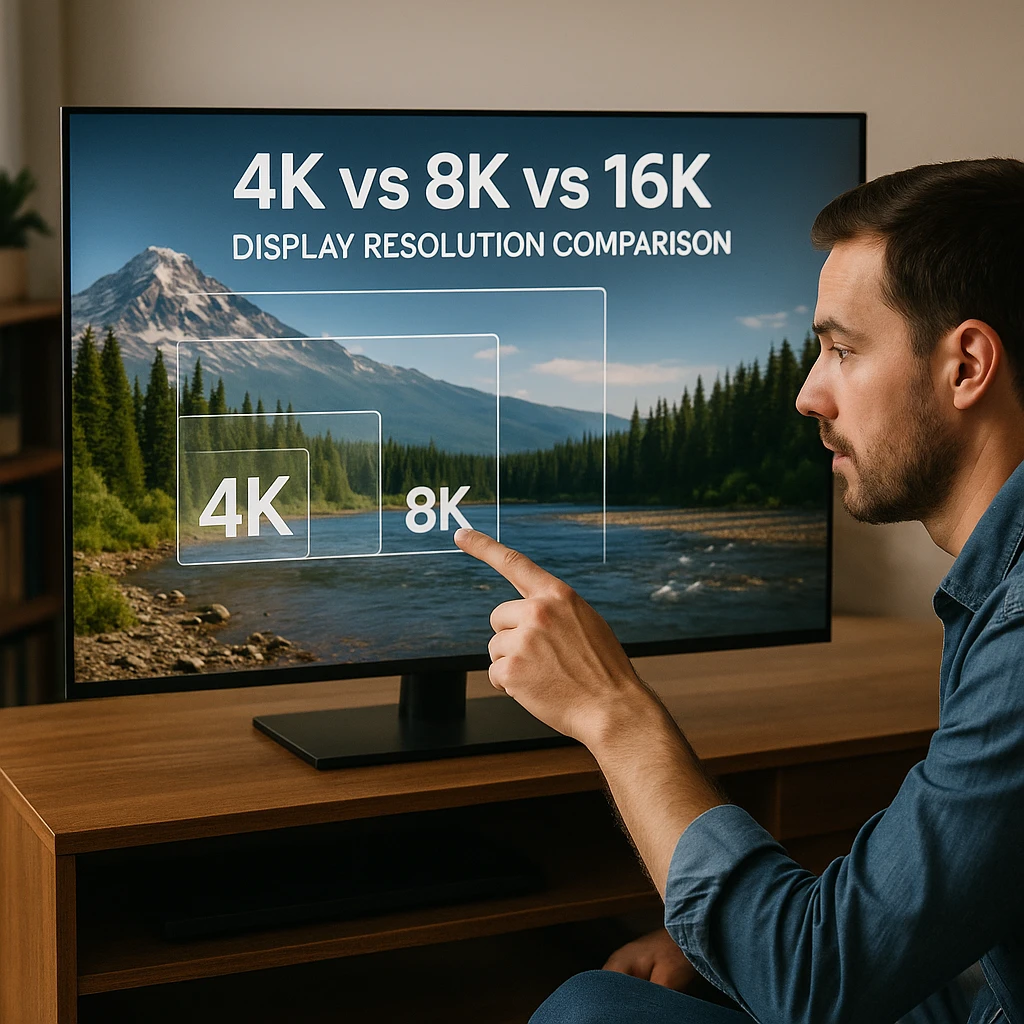In the world of display technology, the race for more pixels is relentless. In 2025, 4K is the established standard, 8K is the premium choice, and 16K looms on the horizon. But is upgrading always better? This guide breaks down the real-world 4K vs 8K difference (and beyond) to help you decide if the extra pixels are worth the investment.
We’ll move past the marketing hype to determine which display resolution comparison makes sense for your specific needs whether it’s for gaming, professional work, or your living room TV.
Resolution Quick Facts 2025
Resolution 101: Understanding Pixels, PPI, and Why They Matter
What Are Pixels? The Building Blocks of Your Screen
A pixel is the smallest unit of a digital image think of it as a tiny colored dot. When millions of these dots combine, they create the pictures you see on your screen. More pixels generally mean sharper, more detailed images, but the story doesn’t end there.
The relationship between pixels and image quality depends heavily on how those pixels are arranged and the distance from which you view them.
Why Pixel Density (PPI) is the True Measure of Sharpness
Pixel Density (PPI) measures how many pixels fit into each inch of your display. This metric often matters more than raw pixel count. A 27-inch 4K monitor delivers 163 PPI, while a 55-inch 4K TV only provides 80 PPI making the monitor appear significantly sharper despite having identical resolution.
PPI Quick Reference
- 27" 4K Monitor: 163 PPI (Excellent for close viewing)
- 32" 4K Monitor: 138 PPI (Great balance)
- 55" 4K TV: 80 PPI (Good for living room distances)
- 75" 8K TV: 117 PPI (Premium living room experience)
The Human Eye Limitation and Viewing Distance
Here’s where physics meets reality. The human eye limitation means there’s a point where additional pixels become imperceptible. At typical TV viewing distances (8-12 feet), most people can’t distinguish between 4K and 8K on screens smaller than 75 inches.
According to DisplayMate’s research on human vision, the average person with 20/20 vision can resolve about 60 pixels per degree of visual angle. This creates a practical ceiling for useful resolution based on viewing distance.
![]()
The Contenders: A Breakdown of Each Resolution
4K (Ultra HD): The Reigning King in 2025
Specs: 3840 x 2160 pixels (~8.3 million total)
Status: The current, widely available standard for high-quality content. Netflix, Disney+, and YouTube all offer extensive 4K UHD libraries. Console gaming on PS5 and Xbox Series X targets 4K as the performance sweet spot.
4K represents the perfect balance of quality and accessibility. Graphics cards can drive 4K gaming at reasonable frame rates, and the content ecosystem is mature. For most users, 4K Ultra HD delivers all the visual fidelity they can actually perceive.
8K: The Enthusiast’s Frontier
Specs: 7680 x 4320 pixels (~33.2 million total)
Status: The premium option for high-end TVs and professional monitors. The challenge? Native 8K content remains scarce. Most “8K” viewing relies on upscaling from 4K sources, though modern upscaling algorithms from Samsung and LG have become surprisingly effective.
Is 8K better than 4K? For large displays (75” and above) viewed at closer distances, yes. For typical use cases, the difference often isn’t perceptible.
16K: A Glimpse into the Future
Specs: 15360 x 8640 pixels (~132.7 million total)
Status: Currently experimental and commercial-grade only. When is 16K resolution coming out for consumers? Industry experts predict 2027-2030 for mainstream availability, though professional applications may see limited releases sooner.
How many pixels is 16K? At 132.7 million pixels, 16K contains 16 times more detail than 4K and 4 times more than 8K. The bandwidth and processing requirements are enormous a single 16K frame requires about 500MB of uncompressed data.
| Resolution | Dimensions | Total Pixels | Vs. 4K | Status 2025 |
|---|---|---|---|---|
| 4K UHD | 3840 x 2160 | 8.3 million | 1x (baseline) | Mainstream standard |
| 8K UHD | 7680 x 4320 | 33.2 million | 4x more detail | Premium option |
| 16K UHD | 15360 x 8640 | 132.7 million | 16x more detail | Experimental/Professional |
Real-World Applications: Where Does Higher Resolution Shine?
PC Gaming: The Ultimate Performance Test
Is 8K gaming worth it over 4K? The honest answer: rarely, in 2025.
8K gaming demands massive GPU power and often requires sacrificing frame rate. Most games target 4K/60fps or 4K/120fps as the performance ceiling. Even NVIDIA’s RTX 4090 struggles to maintain playable frame rates at 8K in demanding titles.
The VRAM requirements alone are staggering 8K textures can easily consume 16GB or more. For competitive gaming, 4K at high refresh rates (144Hz+) provides a better experience than 8K at 30fps.
Do I need an 8K TV for PS5 or Xbox Series X? No. Both consoles target 4K as their performance ceiling, with very few games offering native 8K output. The consoles will upscale to 8K displays, but you’re not getting true 8K gaming.
For content creators working with video, however, online screen recording tools can capture gameplay at various resolutions to help demonstrate these performance differences across different display types.

Video Editing - Graphic Design
This is where 8K makes compelling sense. Professional editors working with 8K footage need displays that can show their content at 1:1 scale while leaving room for timelines and toolbars.
Best monitor resolution for video editing 2025: A 32” 8K monitor (280 PPI) allows editors to view 4K footage at full resolution with space for interface elements. This workflow advantage can save hours of zooming and panning during precise color grading work.
Advanced video editing tools can take advantage of higher resolution displays to provide more screen real estate for complex timelines and effects panels.
The flexibility for cropping and reframing is substantial 8K source material allows for 4K deliverables with significant cropping latitude, effectively providing multiple “virtual cameras” within a single shot.
Home Theater - TVs
The viewing distance argument dominates here. RTINGS research shows that for a 65” TV, you need to sit closer than 8 feet to perceive the difference between 4K and 8K clearly.
Most living room setups place viewers 10-15 feet from their TV, making 8K benefits minimal on screens smaller than 75”. The sweet spot appears to be 85”+ displays for most home theater environments.
Programming - General Productivity
Is a 4K monitor good enough for programming? Absolutely. Code text benefits dramatically from high pixel density, but the gains plateau quickly. A 27” 4K monitor provides crisp text that’s easy to read for extended sessions.
8K doesn’t add meaningful value for coding text doesn’t become more readable, and the additional screen space often requires scaling that negates pixel density benefits. Save the budget for multiple 4K monitors instead.
The Hardware Hurdle: Can Your PC Even Handle 8K or 16K?
The Graphics Card (GPU) You’ll Need
What GPU do I need for 8K gaming? Current options are limited and expensive:
- NVIDIA RTX 4090: The only consumer card approaching 8K gaming. Expect 30-60fps in most titles with reduced settings.
- AMD Radeon RX 7900 XTX: Slightly behind the 4090 but more affordable. 8K gaming possible with significant compromises.
- Future RTX 50-series: Expected 2025, may improve 8K viability significantly.
VRAM requirements scale aggressively. 4K gaming needs 12-16GB VRAM comfortably, while 8K demands 20GB+ for texture-heavy games. Current consumer cards max out at 24GB, creating a bottleneck.
Cables - Ports: The Unsung Heroes
Do I need a special cable for 8K? Yes, absolutely.
- HDMI 2.1: Required for 8K/60Hz. Older HDMI versions cap out at 8K/30Hz or lower.
- DisplayPort 2.0: Supports 8K/60Hz with better bandwidth management than HDMI 2.1.
- USB-C with DP Alt Mode: Some newer laptops support 8K output through high-spec USB-C ports.
Cable quality matters significantly at these resolutions. Cheap cables may not maintain signal integrity over longer distances.
For professional setups involving webcam recording alongside high-resolution displays, ensure your entire signal chain supports the target resolution.
8K Hardware Reality Check
Minimum Requirements:
- RTX 4080 / RX 7900 XT (basic 8K)
- 32GB RAM (64GB recommended)
- HDMI 2.1 or DisplayPort 2.0
- High-quality certified cables
Realistic Expectations:
- 8K gaming: 30-60fps max
- 8K video: Smooth playback
- 16K: Professional/experimental only
- Budget: $3,000+ for capable setup
The Verdict: What Resolution Do You Actually Need in 2025?
After cutting through the marketing noise, here’s what actually makes sense:
For Most Gamers - General Users: 4K High Refresh Rate
4K at 120Hz+ delivers a noticeably better experience than 8K at 30fps. The smoothness improvement from higher frame rates beats additional pixels for most gaming scenarios. A quality 32” 4K monitor hits the sweet spot for desktop use.
For Creative Professionals: 8K Can Be Justified
Video editors, graphic designers, and photographers working with high-resolution content benefit from 8K displays. The workflow improvements and 1:1 scale viewing often justify the investment for professionals billing $100+ per hour.
For Home Theater Enthusiasts: 8K for 75”+ Screens Only
8K TVs make sense for very large displays (75” and above) in dedicated theater rooms where viewing distances are optimized. For typical living rooms with 65” TVs, 4K remains the practical choice. To fully leverage the capabilities of high-resolution displays, platforms like Magis TV provide seamless access to live-streaming movies in stunning clarity, enhancing the overall home entertainment experience.
For 16K: Professional and Experimental Only
16K remains firmly in professional and experimental territory. Medical imaging, scientific visualization, and high-end digital cinema may use 16K, but consumer applications won’t arrive until the late 2020s.
Many professionals working with AI video generation tools find that 4K output quality meets the needs of most clients and platforms, making higher resolutions less critical for content creation workflows.
Beyond the Pixel Count: What Really Matters in 2025
Resolution isn’t everything. HDR (High Dynamic Range), color accuracy, and refresh rate often impact perceived quality more than raw pixel count.
HDR adds brightness range and color depth that’s immediately visible, unlike the subtle gains from 8K resolution. A 4K HDR display often looks more impressive than an 8K SDR screen.
Color gamut coverage (DCI-P3, Rec. 2020) affects how vivid and accurate colors appear. Professional displays prioritize color accuracy over raw resolution.
Refresh rate improvements from 60Hz to 120Hz+ provide smoother motion that’s far more noticeable than resolution bumps in most content.
For creators developing content across multiple platforms, understanding how Instagram and social media optimize different video formats can be more valuable than chasing maximum resolution.
Frequently Asked Questions
Can the human eye really tell the difference between 4K and 8K?
It depends on screen size and viewing distance. For screens smaller than 75”, most people can’t distinguish 4K from 8K at normal viewing distances. However, for very large displays or close viewing (like computer monitors), the difference becomes apparent.
Is it worth buying an 8K TV in 2025 given the lack of native content?
Only for specific scenarios: very large screens (75”+), close viewing distances, or future-proofing for the next 5-7 years. Modern upscaling makes 4K content look good on 8K displays, but true 8K content remains limited.
What is the next resolution after 8K?
16K is the logical next step, offering 15360 x 8640 resolution. However, consumer 16K displays aren’t expected until 2027-2030 due to bandwidth, processing, and cost challenges.
Are there any 16K monitors available to buy today?
A few experimental and professional displays exist, primarily for specialized applications like medical imaging and scientific visualization. Consumer 16K monitors don’t exist in 2025, and the first consumer options likely won’t arrive until 2028-2030.
The gap between professional and consumer technology continues to narrow, but 16K requires solving significant technical challenges around signal processing, heat management, and cost reduction.
Conclusion: Smart Choices Over Specification Racing
The resolution race continues, but smart buyers focus on their actual needs rather than specification sheets. In 2025, 4K delivers excellent quality for most applications, 8K provides real benefits in specific scenarios, and 16K remains a future technology.
Choose based on your workflow, budget, and viewing setup rather than future-proofing for technologies that may not arrive for years. For most users, investing in 4K displays with excellent HDR, color accuracy, and high refresh rates provides better real-world improvements than chasing maximum resolution.
Whether you’re creating content for multiple platforms or simply enjoying high-quality media, understanding these resolution realities helps you make informed decisions that actually improve your daily experience.
The future belongs to better pixels, not just more pixels and in 2025, that future is already here at 4K resolution.



